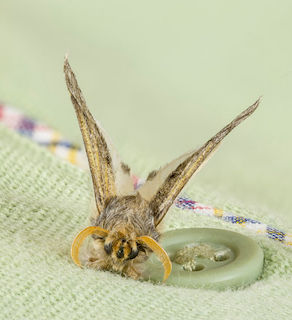There’s a “Hole” Lot You Didn’t Know About Moths
We are in the middle of winter, and one day it’s bound to get freezing cold. The time will come to take out your warmest winter clothing, including your very favorite woolen sweater, the one you had since college. Then, much to your horror, you discover that it has a giant hole right in the middle of the penguin on the front. If that’s not bad enough, you notice several smaller holes in the left arm and on the back. It is only logical to wonder, “what on earth could have caused this?” The answer may actually surprise you.
Most people, when they find holes in clothing, think that those holes were caused by moths, and they would be partially right. There are actually two types of moths in the United States that can present a danger to your clothing: webbing clothes moths and casemaking clothes moths. But, upon inspecting a damaged item, moths are rarely ever found. Why is this? Because the moths you see fluttering around in your closets don’t eat your clothing. In fact, they don’t eat anything at all. They don’t have the mouthparts to eat. They have only one purpose and one purpose alone: make eggs. This is actually where the problem lies.
When a moth’s eggs hatch, hungry larvae come out looking to eat protein–proteins like those found in animal hair and skin, namely wool, fur, feathers, leather, and even lint. Moth babies are even known to chew through cotton, acrylic, polyester, and other plant-based fibers. They don’t eat all these things, but they chew through them to get to their preferred foods. That’s what caused all the holes!
Moth Balls Don’t Work
For most people, the first thing they think to do about moths is go get some moth balls, but this isn’t the best idea. Outside of an airtight container, the concentration of fumes is not enough to totally wipe out moths. These fumes can, however, cause headaches in humans. Here are some slightly better ways to control moths.
Luckily, there are some good ways to control moths, as follows:
- Dry all infested fabric items in a dryer on the highest heat for at least one hour.
- Put items in a thick plastic bag, squeeze all the air out, and deep freeze for at least seven days.
- Discard infested items that cannot be cleaned in tightly sealed plastic bags. Dispose of them somewhere outside.
- Thoroughly vacuum infested areas. Double bag vacuum bags and make sure to discard the bags outside.
- Clean infested areas with hot soapy water.
- Keep the humidity in your home below 40%, especially in closet spaces.
- Inspect your outside walls and roof for gaps and cracks and seal these with a caulking gun.
The BEST way to control moths
If you don’t want to take any chances that more of your favorite clothing items will be destroyed, it is time to call in the pros. Alexandria Pest Services exterminates clothes moths effectively and efficiently by applying an EPA-approved residual insecticide treatment or by using pheromone traps and/or heat treatments when necessary. Don’t let any more of your favorite things be destroyed by clothes moths. Give Alexandria Pest Services a call today and get results.
Call Us to Help You Get Rid of Pests or Rodents!
At Alexandria Pest Services, our trained professionals will analyze your pest control needs and come up with a personalized plan for your household. Our team of expert technicians will provide a free inspection and work to create a plan to eliminate your pests. At Alexandria Pest Services, we help homeowners just like you get rid of pests in their homes all year round. If you find that you are having a problem with insects or pests, and need an exterminator, call Alexandria Pest Services at 703-923-0925 to schedule a professional evaluation. We can help you get rid of these invaders in your home or office!





